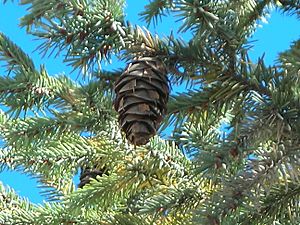Mexican Douglas-fir facts for kids
Quick facts for kids Mexican Douglas-fir |
|
|---|---|
 |
|
| Mexican Douglas-fir branch with cones | |
| Scientific classification |
|
| Kingdom: | Plantae |
| Clade: | Tracheophytes |
| Division: | Pinophyta |
| Class: | Pinopsida |
| Order: | Pinales |
| Family: | Pinaceae |
| Genus: | Pseudotsuga |
| Species: | |
| Varietas: |
P. m. var. lindleyana
|
| Trinomial name | |
| Pseudotsuga menziesii var. lindleyana (Roezl) Carrière
|
|
| Synonyms | |
|
|
The Mexican Douglas-fir (scientific name: Pseudotsuga menziesii var. lindleyana) is a special type of conifer tree. Conifers are trees that produce cones and usually have needle-like leaves, like pine trees. This tree belongs to the Pseudotsuga group.
What makes the Mexican Douglas-fir unique is that it is endemic to Mexico. This means it naturally grows only in Mexico and nowhere else in the world. Scientists have studied its DNA and its physical features. They believe it is closely related to the Rocky Mountain Douglas-fir. Some even think it should be considered another variety of the P. menziesii species.
Where the Mexican Douglas-fir Grows
The Mexican Douglas-fir is found in different mountain ranges across Mexico. It grows in the Sierra Madre Occidental and the Sierra Madre Oriental. You can also find it in scattered mountains as far south as Oaxaca.
Protecting This Special Tree
The Mexican government considers the Mexican Douglas-fir a tree that needs "special protection." This is because there are not many of these trees left. Their groups are small and often far apart from each other.
Scientists have noticed that these trees sometimes have trouble reproducing. They also show signs of low fertility. This means they don't produce as many healthy seeds or young trees. This can happen when plants are too genetically similar, which is like having a very small family tree. This makes them less strong and healthy overall.
Images for kids
See also
 In Spanish: Pseudotsuga menziesii var. lindleyana para niños
In Spanish: Pseudotsuga menziesii var. lindleyana para niños


